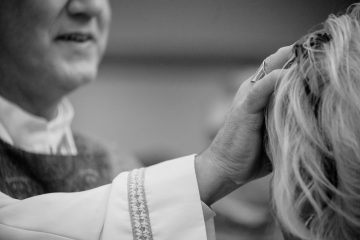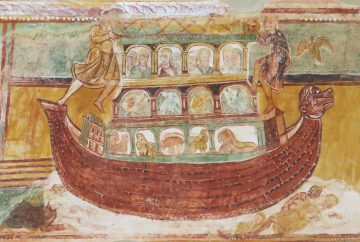A Thought to Share
This category was formerly called “Thought for the Month”

This is an extract from Rev Sheila Cameron’s sermon on 7 May 2023, The Fifth Sunday of Easter, when she was reflecting on our readings in the light of the Coronation of King Charles III the previous day:
Today, as we look forward to Pentecost and the coming of the Holy Spirit, our readings celebrate the status of Christians as God’s chosen people, divinely gifted, and celebrated in that rich variety of images in 1 Peter: we are not only “the stones that the builders rejected,” but also “a chosen race, a royal priesthood, a holy nation, God’s own people.”
You’d be forgiven for thinking there are just too many images here to get your head around. But Christians are all these things, because as followers of Jesus, we have been gifted with the Holy Spirit. The journey begins with baptism, and that includes the gift of the Spirit, a sign of which in our Anglican tradition is the anointing of every new Christian with the oil of chrism …
Yesterday’s moment of anointing, or Act of Consecration, was veiled from the eyes of the public, hidden from the cameras, kept as a moment of deep personal encounter between the new sovereign and God. Like our Lord Jesus Christ, King Charles was anointed “not to be served but to serve.” The moment of anointing was similar to baptism, in the eyes of Christians a transformative moment of encounter and divine gifting.
We read in Acts today of one particular life transformed by the gift of the Spirit, challenged in a way that was irresistible. The death of the first martyr, Stephen, is a shocking story, and yet the focus is not on the violence but rather on the radiance that shines from the face of Stephen. He was “filled with the Holy Spirit, he gazed into heaven and saw the glory of God and Jesus standing at the right hand of God” (Acts 7:55). Like Christ on the mountain, he was transfigured. …
Do read the whole of Sheila’s sermon at this link.
Our picture by Matea Gregg is a slightly lightened version of the one made available on the Unsplash platform.

This is an extract from Rev Sheila Cameron’s sermon on 30 April, The Fourth Sunday of Easter, when she was reflecting on the story of Noah told in Genesis:
… Such Old Testament stories are the foundation of our Christian narrative and our New Testament or covenant with God through Jesus Christ. In the first covenant that God made with humans, he reassured Noah, who was a good and godly man, that he would never again destroy the earth; and, as we read in Genesis 9, the rainbow was given as a sign of that promise. The earth had become an evil and violent place but the Flood brought a fresh, new world living in a new relationship with its Creator. Our Christian baptism is a sign of our covenant with God through Christ: a covenant of grace offered unconditionally. All we have to do is accept in faith the offer of salvation through Christ, for we have inherited eternal life by being baptised into his death and resurrection.
The early Christians saw Noah as a character who called people to repentance; according to Clement of Rome, for example, writing around the year 96, “all who listened to Noah were saved.” The Ark soon came to be seen as prefiguring the Church, which came to be called the “ship of salvation.” …
Sheila went on to talk more about the ship image and the church, the way that the “community of salvation” operated and grew in the early church, and about Christ as our only means of access to salvation. Do read the whole of her sermon at this link.
Our photograph is of a section of the 11th-century murals illustrating the books of Genesis and Exodus on the ceiling of the barrel-vaulted nave of the Abbey Church of Saint-Savin-sur-Gartempe, in Poitou, France. If you don’t have time to visit, as your webmaster did, more delightful images can be found at https://tinyurl.com/mtnwjrud.

This is an extract from Rev Sheila Cameron’s sermon on 9 April, Easter Sunday, when she was expounding on John’s account of the resurrection in John 20:1–18:
… It’s Mary Magdalene, forgiven sinner, friend and devoted follower of Jesus, who takes centre stage in John’s resurrection story, and it is to her that Jesus entrusts the message to the community of his followers that he is alive. This is a very poignant encounter. Mary did not expect to see the face of Jesus again; she wept, not expecting consolation, knowing only loss. Her grief was compounded by the loss of Jesus’ body, all that remained of him. Things couldn’t get any worse. Then in the tomb she saw two angels who spoke comforting words of sorts: “Why are you weeping?” Maybe there was better news ahead.
In the ensuing encounter, as Jesus speaks Mary’s name and she recognises him, a profound change takes place in her relationship with him. She accepts with surprising equanimity that she cannot cling to him and must let him go; the important thing is that he is alive, though changed. He is on his way to his Father, and so cannot be with her or the disciples in the same way as before. The new relationship Jesus offers is still one of presence, but now a presence in another dimension that will last for ever.
God’s reassurance is not far off for those who seek him, as Mary Magdalene discovered. God does care about our griefs and longings and asks us to live in faith that our sorrows will be assuaged in him. This very human account of the resurrection invites us to reflect that love comes to maturity after death. We know that love is not limited by mortality; but that there are times in our lives when we can let go and entrust those we love to God. …
Do read the whole of Sheila’s sermon at this link.
This 1835 painting of Christ’s Appearance to Mary Magdalene after the Resurrection by Russian painter Alexander Andreyevich Ivanov (1806–1858) in the State Russian Museum, St Petersburg, is made available via Wikimedia Commons at this link.